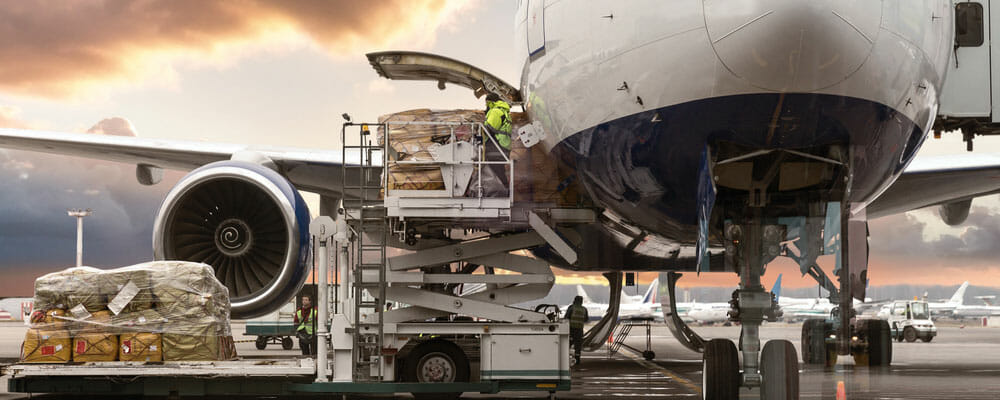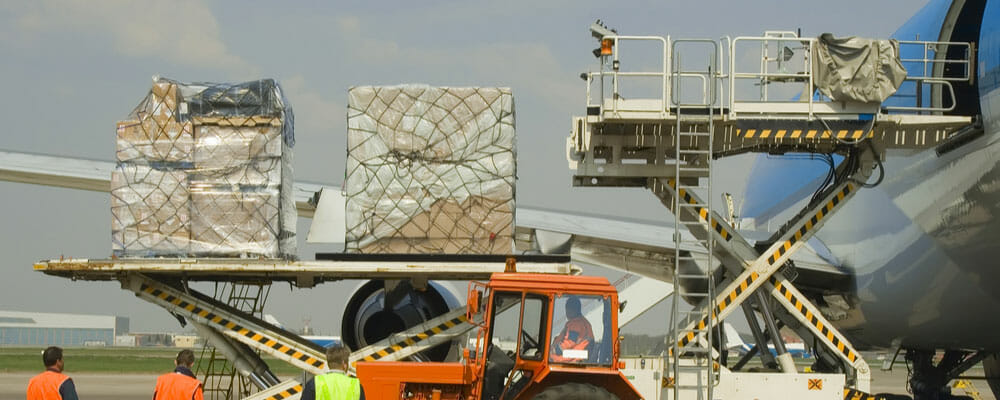Calculating chargeable weight is an essential aspect of air freight shipments, as it directly impacts the cost of transporting goods. The concept of chargeable weight involves determining whether the actual or volumetric weight is more significant, with the more considerable value used to calculate the shipping fees. You can efficiently manage your air freight costs by understanding the differences between actual and volumetric weight and performing the correct calculations.

Air freight shipments must comply with a universal principle considering both the physical space occupied and the weight of the merchandise. Consequently, the chargeable weight is calculated using the more excellent value between the actual and volumetric weights. This allows air freight carriers to find the most balanced approach for pricing their services, ensuring that shipments are fairly charged regardless of size or weight.
Familiarizing yourself with calculating chargeable weight is essential when planning air freight shipments, as it directly affects your transportation efforts’ overall cost and efficiency. By understanding the components of actual and volumetric weight calculations, accurately measuring your shipment, and selecting the appropriate shipping method, you can make informed decisions to optimize your supply chain logistics while effectively managing costs.
Key Takeaways
- Calculating chargeable weight involves comparing actual and volumetric weights and using the more excellent value for shipping fees.
- Understanding the components of chargeable weight calculations is essential for efficient air freight shipment management.
- Accurate measurements and appropriate shipping methods can optimize supply chain logistics while reducing costs.
Understanding Air Freight and Chargeable Weight
When you ship goods using air freight, it’s essential to understand the concept of chargeable weight. Chargeable weight is used to determine the cost of your shipment and is generally the higher of two values: the actual or volumetric weight of the shipment.
Actual weight refers to the gross weight of your shipment, which is simply the total weight of all the packages. This is typically measured in kilograms (kgs).
Volumetric weight, however, considers the shipment’s dimensions and space. This value is calculated by multiplying the length, width, and height of each package in centimeters, dividing the result by a standard conversion factor (usually 6,000 for air freight), and multiplying by the number of packages in the shipment. The result is the volumetric weight in kilograms.
When determining the chargeable weight for air freight shipments, the actual and volumetric weights are compared, and the greater value is used for determining the freight charge.
For example, Consider a shipment of three 10 kg boxes with dimensions 50 x 40 x 40 cm.
- Actual weight: 3 boxes x 10 kgs each = 30 kgs
- Volumetric weight: (50 x 40 x 40 cm) x 3 boxes / 6000 = 40 kgs
In this case, the volumetric weight (40 kgs) is greater than the actual weight (30 kgs), so the chargeable weight for the shipment would be 40 kgs.
Knowing your air freight chargeable weight is essential for accurately estimating the cost of your shipment and ensuring your shipment is transported efficiently and safely. By understanding the difference between actual and volumetric weight and calculating chargeable weight, you will be better equipped to manage your air freight shipments and costs.
Concept of Actual and Volumetric Weight

To calculate the volumetric weight, you’ll first need to measure the dimensions of your package, ensuring you have accurate length, width, and height measurements. Multiply these dimensions together to find the package’s volume.
Next, convert the volume to the appropriate unit of measurement (cubic inches, cubic feet, etc.) if necessary. Freight carriers usually use a specific conversion factor or “dim factor” in their calculations, which can vary between carriers. For air freight, a common dim factor is 167.
Divide the package’s volume by the dim factor to determine its volumetric weight. If calculating in cubic inches, use the following formula: volumetric weight = (length × width × height) / 167. If measuring in other units, use the appropriate conversion factor.
Once you have the actual and volumetric weight calculations, the chargeable weight will be higher than the two values.
This approach ensures that the air carrier is compensated for the space your shipment occupies within their cargo hold, whether a heavy, compact package or a light, large one.
In summary, understanding the concept of actual and volumetric weight and calculating them is crucial when shipping goods via air freight.
This knowledge will help you better grasp your shipments’ costs and space requirements.
Calculating Volumetric Weight
Volumetric weight, known as dimensional weight, is crucial in determining the chargeable weight for air freight shipments. It accounts for the package’s space on the carrier and its actual weight. To calculate the volumetric weight of your shipment, you’ll need to follow a few simple steps.
First, measure the dimensions of your package, including its length, width, and Height, in centimeters. Include any irregularities or protrusions, as they can affect the overall dimensions. Record these measurements to use in your calculations later on.
Next, to find the volume of your package, multiply the length, width, and Height together. The resulting value is the package’s cubic centimeters (cm³) volume. To convert this value to cubic meters (m³) or cubic feet (ft³), use these conversion factors:
1 m³ = 1,000,000 cm³ 1 ft³ = 35,314.7 cm³
After determining the volume, you must apply a volumetric conversion factor to obtain the volumetric weight. The standard conversion factor for air freight is 167 (1 m³ = 167 kg or 6,000 cm³ = 1 kg). Use the following formula to calculate the volumetric weight of your package:
Volumetric Weight (kg) = Volume (cm³) / 6,000
Convert your volumetric weight to kilograms if necessary (1 kg = 2.205 lbs). Now, you have calculated the volumetric weight for your air freight shipment.
To determine the chargeable weight, compare the actual weight of your package to the calculated volumetric weight. The higher of the two values becomes the chargeable weight for your shipment.
Calculating volumetric weight is essential in planning and budgeting your air freight shipments. Understanding how it affects the overall shipment cost allows you to make better decisions and optimize logistics processes.
Differences between Air and Sea Freight

When shipping goods globally, it’s essential to understand the significant differences between air and sea freight, as they can impact your logistics strategy, costs, and overall delivery time.
Air freight offers a faster mode of transport compared to sea freight. It’s ideal for time-sensitive shipments and perishable items. The transit times are significantly reduced, leading to lower insurance premiums. However, air freight is often more expensive than sea freight due to space limitations on aircraft and higher fuel costs. In addition, air freight is generally subject to more stringent regulations, including cargo restrictions on certain hazardous materials.
On the other hand, sea freight offers cost-effective solutions for large and heavy shipments. With a higher cargo capacity, it’s the preferred choice for transporting bulk items, vehicles, and construction equipment. Due to sea freight’s slower transit times, it may not be suitable for perishable or time-sensitive goods. Sea freight allows more flexibility in cargo types and sizes, but working with a reliable freight forwarder is essential to navigating complex customs and regulatory requirements.
When selecting between air and sea freight, consider the following factors:
- Speed: Air freight is significantly faster, ensuring timely delivery, while sea freight may take weeks or months, depending on the shipping route.
- Cost: Air freight charges are typically higher due to fuel costs and aircraft space limitations. Sea freight can be a more economical choice, especially for high-volume shipments.
- Cargo size and weight: Air freight has limitations on cargo size and weight, while sea freight offers flexibility for bulky or heavy items.
- Environmental impact: Air freight has a higher carbon footprint, whereas sea freight tends to be more environmentally friendly.
- Regulations and restrictions: Air freight has stricter regulations on specific cargo types, while sea freight is more lenient.
Choosing between air and sea freight depends on your requirements, budget, and shipment priorities. By working with an experienced freight forwarder, you can effectively plan your shipments and optimize freight charges to achieve the best results for your business.
Role of Freight Forwarders and Couriers
Freight forwarders and couriers are crucial in the logistics and transportation industry. These professionals ensure your goods are shipped and delivered efficiently, safely, and promptly. This section will discuss their roles in calculating chargeable weight for air freight.

Freight forwarders act as intermediaries between you and the transportation service providers. They are responsible for organizing and coordinating all aspects of the shipping process, from documentation and customs clearance to arranging transportation and calculating the chargeable weight for air freight. The chargeable weight for air freight is determined by a volumetric or dimensional factor, which considers both the total volume and actual weight of your shipment.
Your chosen courier company, whether DHL, FedEx, UPS, or TNT, is responsible for transporting your goods from the origin to the destination. The chargeable weight calculation is essential for determining the cost of transportation. To calculate the chargeable weight for air freight, courier companies use a specific formula:
Chargeable Weight = Max(Actual Weight, Volumetric Weight)
The volumetric weight, also known as the dimensional weight, is calculated based on the dimensions of your shipment. This is expressed as:
Volumetric Weight = (Length x Width x Height) / Conversion Factor
Each courier company may have its conversion factor, which can vary slightly from one provider to another. It’s essential to consult with your chosen courier for accurate information and conversion factors.
To ensure that you select the right freight forwarder and courier for your shipping needs, it’s essential to:
- Compare the services offered by different providers
- Review their track records and references
- Assess their experience in handling similar shipments
- Evaluate their ability to offer customized solutions as per your requirements
Overall, understanding the role of freight forwarders and couriers in calculating chargeable weight for air freight can help you make informed decisions and optimize the shipping process for your goods.
Calculating Chargeable Weight for Different Materials
When shipping different materials, such as cotton and steel, it’s essential to calculate the chargeable weight to determine the cost of air freight. The chargeable weight considers the actual and volumetric weights of the shipment, using the more excellent value.
Cotton shipments: Cotton, being light but voluminous, often has a volumetric weight surpassing its actual weight.
- Measure the packaged cotton’s dimensions (length, width, and Height) in centimeters.
- Multiply these dimensions and divide by the air cubic conversion factor, typically 6,000 for air freight.
- Ensure you use metric measurements, with cubic meters for volume and kilograms for weight.
For example, if a cotton shipment has dimensions of 120cm x 80cm x 50cm:
Volumetric Weight = (120 x 80 x 50) / 6000 = 80kg
Compare this volumetric weight to the shipment’s weight and use the more excellent value as the chargeable weight.
Steel shipments: Steel products are more substantial and denser than cotton. Thus, their actual weight is likely higher than their volumetric weight. However, it’s still crucial to calculate the actual and volumetric weights, as carriers will use the more excellent value. Follow the same process as cotton shipments – measure the dimensions, multiply them, and divide by the air cubic conversion factor.
For example, if a steel shipment has dimensions of 100cm x 50cm x 40cm and an actual weight of 320kg:
Volumetric Weight = (100 x 50 x 40) / 6000 = 33.33kg
In this case, the actual weight of the steel shipment (320kg) is greater than the volumetric weight (33.33kg), making the chargeable weight 320kg.
By following these steps and understanding the differences in calculating the chargeable weight of various materials, you can accurately estimate air freight costs for your shipments. Be sure to provide correct weight and dimensions measurements to avoid unexpected fees or miscalculations.
Understanding Shipping Costs and Freight Charges
Understanding how shipping costs and freight charges are calculated is crucial when shipping goods via air freight. It helps you make informed decisions and keep your expenses in check. In this section, we will focus on the concept of chargeable weight as it plays a significant role in determining the cost of air freight.

Chargeable weight is a critical parameter air freight carriers use to determine how much you will pay for your shipment. It considers both your package’s actual gross weight and volumetric weight. The method has been developed to account for the amount of space a shipment takes up in an airplane’s cargo hold and its actual weight. So, it ensures the total weight and the space utilized in the plane are considered when calculating the shipping cost.
To calculate the chargeable weight, here are the steps you need to follow:
- First, find the actual gross weight of your shipment. This is the total weight of your goods, including all packaging materials. Weigh your shipment and note down the weight in kilograms.
- Next, determine the volumetric weight of your shipment using either the centimeter or inch formula. Measure your shipment’s length, width, and Height in centimeters or inches.
- If using centimeters: Volumetric weight (in kg) = (Length x Width x Height) x number of boxes / 6,000
- If using inches: Volumetric weight (in kg) = (Length x Width x Height) x number of boxes / 366
3. Now, compare the actual gross weight and the volumetric weight. The chargeable weight for your shipment will be the higher of the two values.
Here’s an example to help you visualize the process:
- Actual gross weight: 3 boxes with 10 kg each, total = 30 kg
- Volumetric weight (using centimeters): (50 x 40 x 40 cm) x 3 boxes / 6,000 = 40 kg
- Volumetric weight (using inches): (19.6 x 15.7 x 15.7) x 3 boxes / 366 = 40 kg
- Result: 40 kg is greater than 30 kg, so the chargeable weight is 40 kg.
By understanding the concept of chargeable weight and how it affects your shipping costs, you can better plan your air freight shipments and avoid surprises when paying freight charges.
Impact of Packaging on Chargeable Weight
When shipping via air freight, it’s essential to consider how the packaging can impact the chargeable weight. The chargeable weight is the higher value between the actual weight of your shipment and its volumetric weight. Evaluating your packaging choices is crucial to ensure you’re utilizing space and resources efficiently.

- Standard Package Measurement – It often depends on the industry but typically involves standard-sized cartons or boxes. This packaging makes it easier for pallets to be stacked and helps avoid unused space in your shipments. Using a standard package measurement, you can optimize pallet load and effectively reduce the chargeable weight.
- Surface Package Measurement – This is an essential aspect to consider because it directly affects the volumetric weight of a package. To calculate the volumetric weight, multiply your package’s dimensions (length x width x height) and divide the result by the dimensional factor (usually 167 for air freight). This calculation is crucial for irregular packages, as any unoccupied space can lead to an inflated chargeable weight.
- Irregular Packages – When dealing with irregular packages, it is essential to pack these items to minimize unutilized space carefully. This will help you significantly reduce the volumetric weight and, consequently, the chargeable weight. Utilizing custom-made packaging or protective materials can help achieve a more space-efficient result.
- Carton Size – This directly affects the size and weight of your overall shipment. Consider using smaller, more space-efficient cartons without compromising the safety and security of your products. Remember that a smaller carton size can help lower the volumetric weight and reduce chargeable weight.
- Pallet Usage – When using pallets, you must stack your packages efficiently and securely to use the available space on the pallet wisely. Proper stacking can increase the stability and protection of the shipment while reducing the overall chargeable weight.
In summary, packaging plays a significant role in determining the chargeable weight of your air freight shipment. By considering the package measurements, carton size, and pallet usage, you can substantially reduce the chargeable weight and make your shipments more efficient and cost-effective.
Utilizing Chargeable Weight Calculators
You can use a chargeable weight calculator to simplify this process and achieve accurate results.
A chargeable weight calculator is an online tool that helps you determine the chargeable weight of your shipment quickly and easily. All you need to do is input the dimensions (length, width, and Height) and the actual weight of your package. The calculator will then compare the actual and volumetric weights and provide you with the chargeable weight.
There are various chargeable weight calculators specifically designed for air freight shipments. You can find some calculators on freight company websites or shipment booking platforms, such as Freightos. These calculators often provide additional features, like converting measurements between different units or handling multiple packages in one calculation.
To ensure you get the most accurate results, measuring your packages correctly and inputting the accurate values into the calculator is essential. Pay close attention to the units of measurement used by the calculator and convert your values accordingly if needed.
In summary, utilizing a chargeable weight calculator for air freight shipments can save you time and effort in determining your shipping costs. Just measure your packages accurately, input the correct values, and use the appropriate calculator to get the most accurate results.
Types of Transportation and Their Influence on Chargeable Weight
When calculating chargeable weight, the mode of transportation you choose plays a significant role. Each type of transportation—air freight, sea freight, road freight—has unique factors that impact the final chargeable weight. Understanding these differences can help you make informed decisions when shipping your goods.
Air Freight
In air freight, the chargeable weight is calculated based on the greater of the actual weight or the volumetric weight. Volumetric weight is determined by multiplying the package’s dimensions (L x W x H) and dividing the product by a dimensional factor, typically 6,000 for air freight. This calculation considers the cargo’s physical size and weight concerning the limited air transport capacity.
Example calculation for air freight:
Volumetric Weight = (L x W x H, in centimeters) / 6,000
Sea Freight
Sea freight chargeable weight calculations vary based on whether your cargo is a full-container-load (FCL) or a less-than-container-load (LCL). For LCL shipments, the volumetric weight is calculated based on the dimensions of the package by using the formula:
Volumetric weight = (L x W x H, in centimeters) / 1,000
For FCL shipments, a per-container charge replaces the volume-based charge, and the container’s total weight must not exceed the maximum weight limit specified by the shipping company.
Road Freight
Road freight, also known as trucking, typically calculates chargeable weight based on the greater of the actual weight or the volumetric weight of a shipment. Volumetric weight for road freight is calculated by dividing the product of the package’s dimensions by a dimensional factor, which varies depending on the carrier. In some cases, density-based pricing may be applied, which factors the cargo’s size and weight.
When selecting a mode of transportation, consider the requirements of your shipment, such as deadlines, cost constraints, and cargo characteristics. Each mode of transportation has advantages and disadvantages, from cost to speed and space availability. Weigh your options and choose the best method to efficiently transport your goods while keeping your chargeable weight and overall costs minimal.
Warehousing and Its Influence on Chargeable Weight
Its influence on chargeable weight for air freight must be noticed regarding warehousing. As you manage your cargo in a warehouse, understanding how the warehouse organization and storage techniques affect your chargeable weight can help you make better decisions and save on costs.

Warehousing is crucial in determining your cargo’s volume and gross weight. Properly organizing and storing your goods can significantly impact the space they occupy. This, in turn, influences the volumetric weight, one of the factors considered while calculating chargeable weight for air freight.
Frequently Asked Questions
1. What is the formula for calculating volumetric weight?
Volumetric weight is calculated using the formula: (Length x Width x Height, in centimeters) / 6,000 (for air freight). This formula is applied to each package in a shipment. Remember always to use the length, width, and Height in centimeters when calculating.
2. How do you convert CBM to chargeable weight?
To convert CBM (Cubic Meters) to chargeable weight, first, measure the dimensions of your shipment in centimeters (L x W x H). Then, multiply the dimensions and divide the volume by 1,000,000 to get CBM. Finally, divide the volume (in CBM) by the dim factor of 6,000 (for air freight) to get the chargeable weight (in kg).
3. What’s the difference between chargeable weight and gross weight?
Chargeable weight is the weight used for billing purposes, whereas the gross weight is the actual physical weight of the shipment. The chargeable weight can be the volumetric weight based on a shipment’s dimensions or the actual gross weight, whichever is greater. This ensures that carriers are fairly compensated for the space and weight of the cargo.
4. When does volume charge air cargo instead of weight?
Air cargo is charged by volume when the volumetric weight is greater than the actual gross weight of the shipment. This is because some light but large shipments take up more space on an aircraft than their actual weight would suggest, affecting the carrier’s capacity to carry additional cargo.
5. How can I determine the chargeable weight for different types of freight?
Use the formula (L x W x H, in centimeters) / 6,000 for air freight to calculate volumetric weight. For other types of freight, like road, ocean, and rail, it’s best to consult with your carrier, as density ratios and dim factors may vary by location and specific transportation processes.
6. What is the role of dimensions in calculating chargeable weight?
Dimensions (length, width, and Height) are crucial in calculating chargeable weight, particularly for light but bulky cargo. By taking dimensions into account, carriers can ensure they are fairly compensated for the space occupied by the cargo, as well as its physical weight. The dimensions are vital in calculating volumetric weight, which is used for billing purposes if it is greater than the actual gross weight of the shipment.
Use Our Air Freight Services Today

For the best rates and air freight shipping experience, hire us. All you have to do is send us a message via the customer contact form on our website. We will guide you on how to take advantage of our excellent air freight services.
